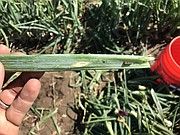Growing onions in the Columbia Basin isn't as easy as it may seem
Onion growers on both sides of the Columbia River deal with a lot of common problem areas. In times past, they have had difficulty finding solutions through local research that can bring relief from the issues plaguing their crops.
But a system in place; the Columbia Basin Onion Research Committee, provides the necessary vehicle to help ease their concerms.
“The Columbia Basin was the only major onion production region in the country that hadn’t gotten together formally to talk about research and funding for the many obstacles growers face,” said Regional Vegetable Specialist and Franklin County Director at Washington State University Extension Tim Waters, who is the advisor to the committee. “So the committee was formed to find answers to problems they were dealing with.”
Although the committee was officially up and running last year, Waters said there are a lot of growers who have yet to take advantage of all there is to offer.
“We’ve had pretty good participation, but not all growers are participating yet and the idea of this thing is a collective thing that helps all growers, so we want more growers to participate in the process,” Waters said. “They all have common issues and we want to work on them, so it makes it better for everyone in the long run.”
The non-profit committee is composed of growers from different regions with different size operations who’ve reached out to their neighbors to find out problems they are having growing onions. The four board members are Larry Bauman from Connell, Lorin Grigg from Quincy, Michael Locati from Walla Walla, and Taryn Hartley from Prosser.
Waters said it’s difficult to address research questions without a funding mechanism in place. There are places researchers can apply for money for projects but a lot of those entities require matching funding from growers to be able to get research funding. So the hope was that if growers could put collective dollars together and provide money to get projects going, researchers could go to the USDA or Washington State Department of Ag’s block grant program and apply for matching funding.
“The growers decided to impose a self-assessed rate of $5 per acre that goes into a committee fund,” Waters said. “The committee then sends out a request for proposals to researchers in the Columbia Basin to let them know the problems growers are facing and to ask them to submit them based on their priority areas. The committee then reviews the proposals to decide which ones to fund.”
Waters serves as the advisor to the committee. His role is to make growers aware of specific issues and help them find the answers their questions concerning research proposes being submitted.
“Working for WSU Extension I get calls from growers all across the Columbia Basin with varying onion issues. I am an Entomologist by trade so I can help them understand the research projects a little bit better.”
Many of the issues growers face, Waters said, are problems with the Irish Yellow Spot Virus, Downey mildew and internal dry scale.
“Growers in the north central Columbia Basin have dealt extensively with the Irish Yellow Spot Virus. Onion thrips eating on the plant creates a lot of damage that results in a vector virus. Another issue that has come up recently is Downy mildew – a fungal disease caused by a pathogen that can be attributed to the vary







